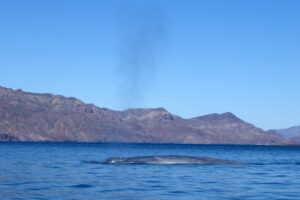Blue Whale, Balaenoptera musculus
 Blue Whale, Balaenoptera musculus. Whale viewed cruising the coastal waters off Loreto, Baja California Sur, March 2017.
Blue Whale, Balaenoptera musculus. Whale viewed cruising the coastal waters off Loreto, Baja California Sur, March 2017.
 Blue Whale, Balaenoptera musculus. Underwater photograph featuring Bob Hillis, my good friend, strong contributor to this Web Site and one brave hombre, taken in coastal waters off San Diego in April 2012 by Mike Johnson, San Diego, California.
Blue Whale, Balaenoptera musculus. Underwater photograph featuring Bob Hillis, my good friend, strong contributor to this Web Site and one brave hombre, taken in coastal waters off San Diego in April 2012 by Mike Johnson, San Diego, California.
Phylogeny: The Blue Whale, Balaenoptera musculus (Linnaeus, 1758), is a member of Baleen, Rorqual, or Balaenopteridae Family of Whales, that is known in Mexico as ballena azul. Although there are several subspecies of the Blue Whale, the species found in Mexican waters is Balaenoptera musculus intermedia.
Morphology: The Blue Whale are huge whales, with a slender, streamlined profile and thought to be the largest living animal ever present on Earth. They have flattened heads with a large “splashguard” that lies in front of the two blowholes, which appears “U” shaped from above. The dorsal fin is small relative to body size and exhibits a falcate to triangular shape. Their flippers are long: 3.0 m (9 feet 10 inches) to 4.0 m (13 feet 1 inches) in length and pointed. The flukes are triangular with a fairly straight trailing edge with only a small median notch. The throat pleats run from the snout to the navel. Blue Whales have a mottled blue-gray color with a lighter color ventrally. In sunlight, just under the surface these whales appear light blue or aquamarine. In some locations, they are coated with diatoms that form a yellowish sheen on the whale’s underside. For this reason, they are sometimes called Sulfur-Bellies. The largest documented Blue Whale was 33.3 m (110 feet) in length and was in excess of 180,000 kg (400,000 lbs). They are sexually dimorphic with female Blue Whales being 1.5 m (5 feet) to 3.0 m (10 feet) longer than the males. The largest Blue Whales are currently found in the coastal waters off Antarctica.
Diet: The Blue Whale feed primarily on krill (Euphausia pacifica, Thysanoessa inermis, Thysanoessa longipes, Thysanoessa spinifera, Nyctiphanes symplex and Nematoscelis megalops), but in the process of feeding often ingest other plankton and small fish. They have been documented to consume up to 40,000,000 krill or 3,600 kg (7,900 lbs) per day. The Blue Whales of Baja California are known to eat the Pelagic Red Crab, Pleuroncodes planipes.
Behavior: Blue Whales are usually found in small groups of two or three individuals, but may be found in groups as large as sixty, in the first 100 m (330 feet) of the water column. They can reach speeds of 50 km per hour (31 mph) and typically travel about 15 m (50 feet) under the surface. Harpooned Blue Whales have been known to dive in excess of 500 m (1,640 feet). Although this aquatic creature breathes air, it is capable of remaining submerged for up to 21 minutes. Calves are preyed upon by large sharks and Killer Whales, but the adults have no predators due to their size, power, and speed. Blue Whales are capable of emitting a very loud, low frequency sound that lasts between ten and thirty seconds and can carry for thousands of miles in the deep ocean, that is audible by humans.
Reproduction: Blue Whale reproduction occurs via internal fertilization followed by a 10 to 12 month gestation period. A typical female will give birth to one 2,700 kg (6,950 lb), 7 m (23 feet) calf every two or three years. The calves consume 100 gallons of mother’s milk per day for 7 months putting on 90 kg (200 lbs) per day and doubling in length. Blue Whales have life spans of between 80 and 110 years.
Distribution: The Blue Whales are highly migratory, spending the summer in the cool, high latitudes, where they feed in krill-abundant waters, followed by a winter spent in warmer, low latitudes, where they mate and give birth. They are found in the open ocean in all tropical, temperate, and polar seas including the entire Pacific Coast of Mexico, and the Southern and Central Sea of Cortez.
Endangerment Status: From a conservation perspective the Blue Whale is currently considered to be ENDANGERED. At the beginning of the 20th Century they were abundant with an estimated population of 200,000 to 300,000, but have since been hunted to near extinction. They became protected internationally in 1996, and global populations were estimated to be 5,000 in 2002. Today’s there are approximately 10,000 to 25,000 with the North Pacific population having rebounded to 3,000 to 5,000 individuals. They are most commonly killed by collision with ocean vessels and fishnet entanglement. It is also believed that sonar continues to have a negative effect on Blue Whale communications. Recently, polychlorinated biphenyls (PCB’s) have been found within their bodies. PCB’s are thought to impact disease resilience and the reproduction in whales. Global warming is also thought to be of major threat to the Blue Whales as their food supply may migrate to different locations and become less abundant. Blue Whales are abundant in the coastal waters off the northwest coast of Baja from March to September and in Loreto, Baja California Sur, during the months of January, February and March. Their skeletons can be found globally in numerous large museums.
Synonyms: Balaena musculus, Balaena borealis, Balaena maximus, Balaena musculus, Balaenoptera carolinae, Balaenoptera gigas, Balaenoptera indica, Balaenoptera jubartes, Balaenoptera miramaris, Balaenoptera sibbaldi, Physalus latirostris, Physalus sibbaldii, Pterobalaena gigas, Pterobalaena grypus, Rorqualus boops, Rorqualus borealis, Rorqualus major, Sibbaldius antarcticus, Sibbaldius borealis, Sibbaldius musculus.